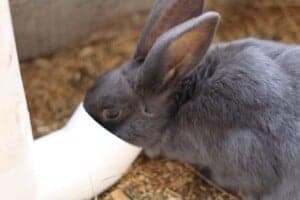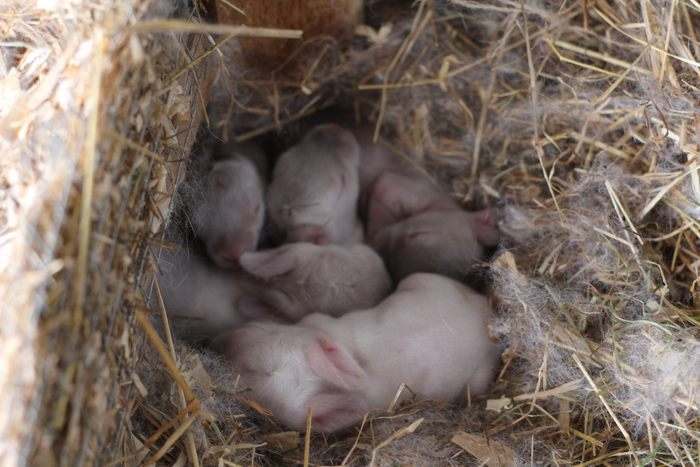This post was most recently updated on July 27th, 2021
Growing meat rabbits is basically easy. Put boy rabbits and girl rabbits in together with food and eat the excess bunnies. Simple right??
Please read: This information is provided for educational purposes only and is not intended to treat, diagnose or prevent any disease. We encourage you to make your own health care decisions in partnership with a qualified health care professional.
This post contains affiliate links, this means at no extra cost to you, we make a commission from sales. Please read our Disclosure Statement
Unfortunately it can be a little more complicated than that if you want to be efficient and aim for optimum growth in meat rabbits.
How to fatten up meat rabbits quickly
Here are four tips and tricks that will ensure that you are getting the most meat for the smallest amount of feed/effort.
Step One: Start with Good Stock

Choose a breed known for growing big, fast. See my article about choosing a breed of meat rabbits for more tips on this.
A proven meat line from someone that actually breeds rabbits for meat is going to be much more useful to you than a show rabbit with a pedigree.
If you are planning on raising meat rabbits in a colony like we do (and we recommend that you do), I suggest you try and find a colony breeder or at least get very young stock.
Living in a colony is a big change to cage life, young ones adapt faster to the change if all you can find is caged rabbits. It is worth being patient about this.
Want to know all about raising rabbits in a colony?
Check out our very own book here:
Available on Kindle and in paperback or from our store
What to look for in healthy stock for optimum growth in meat rabbits:
Overall Health – Clear eyes, sleek clean coat, clean ears, even teeth with the top ones in front of the bottom.
A good conformation – Meat rabbits should be the shape of a ball. Their hips should be about as wide as their shoulders, and when viewed from the side, they should be nice and rounded. The 104 homestead have some great photos showing the difference.
Age – You should not buy rabbits under 8 weeks of age, they should stay with their mother until then. This ensures they get the best start to life.
Rabbits should be bred between 18-26 weeks of age to avoid loss of their first litters. If your rabbit is older than this, ask about their breeding history – number of litters, number of kits, number of survivors to weaning age.
I would avoid any rabbits that are over a year old that have not yet had litters, they are often too fat to breed by that stage. If they do manage to breed, many does will find it too stressful to adjust to and really struggle with motherhood.
Temperament – Ideally your rabbits will have had contact with humans right from the start. Avoid any that are aggressive or absolutely terrified, as they will be difficult to have in a colony setting.
Weight – At 8 weeks a good line of rabbits will be about 3lb (1.5kg), an amazing line will be closer to 5lb (2.5kg). By 9 months your rabbit should have pretty much reached its ideal adult weight for its breed. For most meat breeds this is 8-11lb (4-5.5kg).
Step Two: Provide Quality Housing
Rabbits need to be kept dry and out of the wind. Other than that, how you house them is really up to you. We prefer a colony set up.
Colony rabbits grow more lean, with more muscle mass than their caged counterparts due to all the running around that they do..
One option for housing rabbits is in the dirt. There is a lot of benefit to allowing your rabbits to live in and on the dirt. One of the most significant benefits to dirt is that it is an amazing insulator.
Cold bunnies don’t grow well. Trying to keep themselves warm uses a lot more calories, and the rabbits will be eating a lot more food and growing much slower when they are cold.
For optimum growth in meat rabbits you need them to be able to stay warm. You don’t need to heat their housing, but they do need to be able to make a warm nest somewhere sheltered and dry.
Here is some photos to show you what impact the cold can have. These litters were the same size and weight when born, and are from sisters and born within 24 hours of each other.
This litter is born in a dry warm nesting box with a good layer of hay under their nest.
This litter is over in the middle of nowhere, beside the cold tin siding and straight on top of the cold, damp bricks on the floor.
As they are Californians, the color on their nose/ears/tail/feet is temperature controlled – the little grey baby is in fact a white bunny that got chilled all over and triggered the color genes.
You can clearly see the size difference between these two babies, one from each litter. The colder litter are all much smaller than the warmer litter.
Step Three: Feed Quality Food
For optimum growth in meat rabbits they need a high quality, high protein feed.

Naturally fed rabbits need a half cup of safe greens per pound (500g) live weight per day. See our post on feeding rabbits for a list of safe foods.
They will also need free access to a quality grass hay, some alfalfa (lucerne) hay and some grains – barley, oats and wheat are all good options.
Protein values of common options are:
Barley -12.2%
Oats – 16.9%
Red Wheat – 15.5%
Alfalfa – 17%
Sunflower seeds – 16.1%
Peas – 23%
Hay – 7-10%
Barley fodder at day 6 – 20.2%
You can raise rabbits very well on barley fodder. With free-choice hay always available to them.
Related: The Ultimate Guide to Keeping Rabbits in a Colony
Step Four: Breed for Size
As you breed your rabbits, keep good records as the kits grow. You will want a record that includes the following:
Name of Doe
Name of Buck
Litter Size
No. Live Born
No. Survived to weaning
Weights of kits at 4,8 & 12 weeks – more if not at slaughter weight (5lb/2.5kg) by 12 weeks
Keep an eye out for patterns. You want to know what buck/doe combinations do the best. Who your best mothers are and keep looking for kits that are of good shape and grow quickly.
Cull any stock that fail to thrive, fail to produce litters or fail to raise young to weaning. Most breeders give their rabbits 3 chances to get a surviving litter.
To cull means to either eat/kill them or just to remove them from the breeding program.
Keep your best kits to replace your adult stock regularly. Most rabbits will produce well until they are about 4 years old. Some continue for several years more after that.
Keep them Healthy

Only breed rabbits that appear to be in good health, and be ruthless with your culling from the breeding program.
Any breeder that produces sickly kits consistently needs to go. As does any doe that is clearly sickly herself.
Does that have trouble with mastitis or gut problems also should be culled from the breeding program.
Rabbits that are kept clean, dry and well fed seldom get struck by illness. But it does happen. It is up to you weather you choose to treat, or take the hard line approach and simply put them out of their misery.
Our rabbit disease guide has symptoms for most illnesses that rabbits will get, and both herbal and conventional treatment options.
How to build muscle in rabbits
Meat is muscle, if you want to build muscle on your rabbits, the best thing you can do is to let them run around.
A high protein diet and genetics also comes in to play here as well.
So there you have it, four ways to improve your meat rabbits growth ensuring that your grow outs grow as quickly and as well as possible.
Do you do anything to ensure your meat rabbits grow well? Let me know in the comment below.
Want to know all about raising rabbits in a colony?
Check out our very own book here:
Available on Kindle and in paperback or from our store
Please Pin and Share with your Friends!














